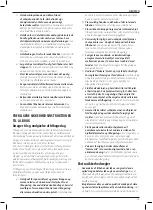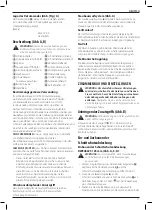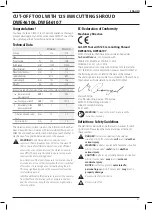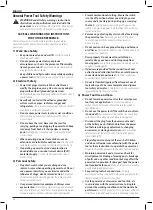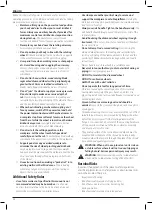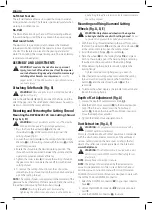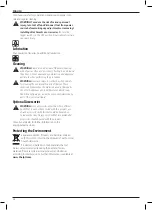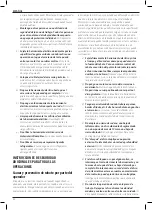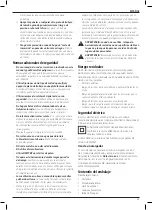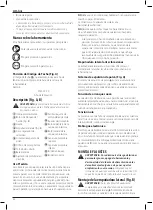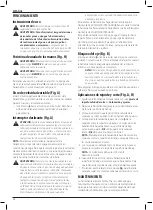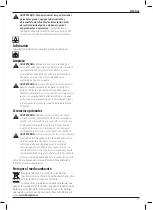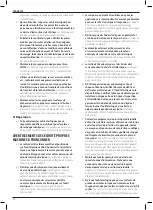
25
EngLIsh
• Health hazards caused by breathing dust developed when
working in concrete and/or masonry.
Electrical Safety
The electric motor has been designed for one voltage only.
Always check that the power supply corresponds to the voltage
on the rating plate.
Your
D
e
WALT
tool is double insulated in accordance
with EN60745; therefore no earth wire is required.
WARNING:
115 V units have to be operated via a fail-safe
isolating transformer with an earth screen between the
primary and secondary winding.
Cord shall only be replaced by DEWALT service agencies.
Mains Plug Replacement
(U.K. & Ireland Only)
If a new mains plug needs to be fitted:
• Safely dispose of the old plug.
• Connect the brown lead to the live terminal in the plug.
• Connect the blue lead to the neutral terminal.
WARNING:
No connection is to be made to the
earth terminal.
Follow the fitting instructions supplied with good quality plugs.
Recommended fuse: 13 A.
Using an Extension Cable
If an extension cable is required, use an approved 3–core
extension cable suitable for the power input of this tool (see
Technical Data
).The minimum conductor size is 1.5 mm
2
; the
maximum length is 30 m.
When using a cable reel, always unwind the cable completely.
Package Contents
The package contains:
1 Cut-off tool
1 Side handle
1 Hex wrench
1 Cutting shroud
1 Locking flange
1 Backing flange
1 Instruction manual
• Check for damage to the tool, parts or accessories which may
have occurred during transport.
• Take the time to thoroughly read and understand this manual
prior to operation.
Markings on Tool
The following pictograms are shown on the tool:
Read instruction manual before use.
Wear ear protection.
Wear eye protection.
Date Code Position (Fig. A)
The date code
19
, which also includes
the year of manufacture,
is printed into the housing of the cut-off tool and shroud.
Example:
2020 XX XX
Year of Manufacture
Description (Fig. A, B)
WARNING:
Never modify the power tool or any part of it.
Damage or personal injury could result.
1
Slide switch
2
Spindle lock button (Fig. B)
3
Spindle
4
Side handle (Fig. B)
5
Variable speed dial
6
Dust ejection system
7
Swiveling dust port
8
Collar screw
9
Metal base
10
Depth of cut adjustor
11
Depth of cut adjustment
knob
12
Removable wheels
13
Front shroud button
14
Side shroud button
15
Upper shroud
16
Lower shroud
17
Locking flange
18
Backing flange
Intended Use
Your cut-off tool with cutting shroud has been designed for
professional masonry cutting applications. It is not intended for
use with metal or wood. It may used only for dry cutting. Using
the appropriate diamond wheel and dust extractor vacuum can
be used to remove the vast majority of static and airborne dust
which without the use of the cutting shroud could otherwise
contaminate the working environment or pose an increased
health risk to the operator and those in close proximity.
DO nOt
use under wet conditions or in the presence of
flammable liquids or gases.
The cut-off tool with cutting shroud is a professional tool.
DO nOt
let children come into contact with the tool.
Supervision is required when inexperienced operators use
this tool.
•
Young children and the infirm.
This appliance is not
intended for use by young children or infirm persons
without supervision.
• This product is not intended for use by persons (including
children) suffering from diminished physical, sensory or
mental abilities; lack of experience, knowledge or skills
unless they are supervised by a person responsible for their
safety. Children should never be left alone with this product.
Anti-vibration Side Handle
The anti-vibration side handle offers added comfort by
absorbing the vibrations caused by the tool.
Dust Ejection System (Fig. A)
The dust ejection system
6
prevents dust pile-up around the
guard and motor inlet, and minimises the amount of dust
entering the motor housing.
Summary of Contents for DWE46106
Page 1: ...DWE46106 DWE46107 Final Page size A5 148mm x 210mm ...
Page 3: ...1 Fig A 6 5 1 13 8 7 12 14 11 9 15 16 12 10 18 17 3 XXXX XX XX 19 XXXX XX XX 19 ...
Page 4: ...2 Fig D Fig E Fig B Fig C 4 2 20 8 21 18 3 24 17 ...
Page 5: ...3 Fig H Fig F Fig G 23 22 7 25 12 9 26 12 9 4 ...
Page 118: ......
Page 119: ......





